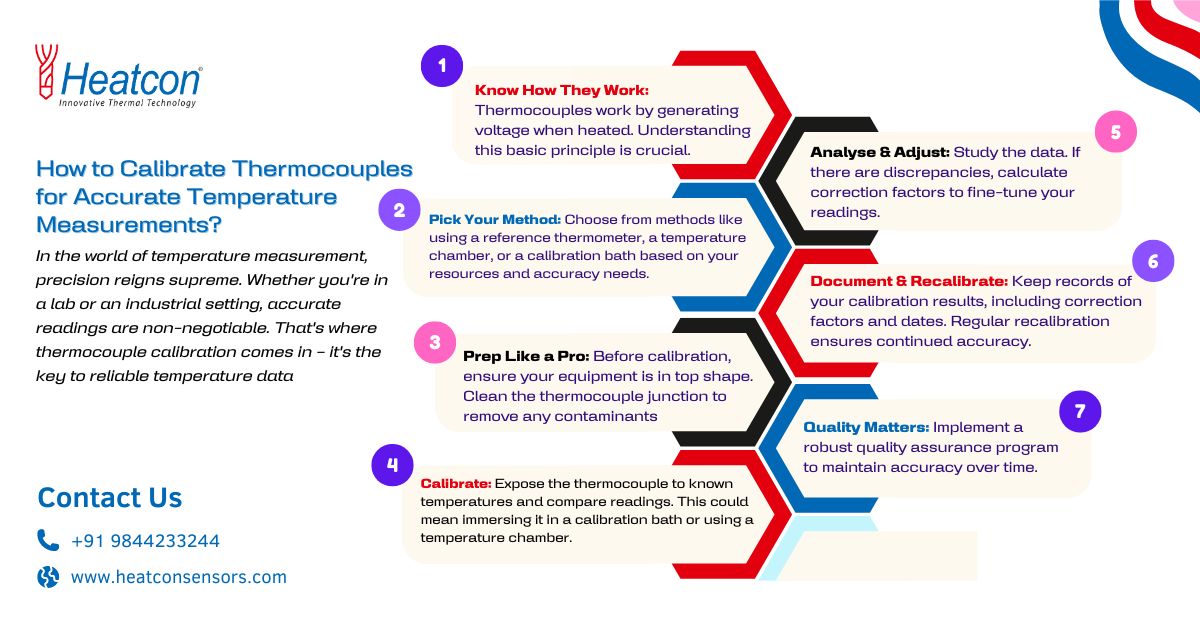Conquering the Domain of Temperature Measurement
In the vast temperature sensing domain, exactness is very crucial. Whether you have been working in a lab setting or wish to achieve accurate temperature measurements in any other such industrial environment, calibration of thermocouples is much needed to guarantee reliable temperature readings. Thermocouples happen to be those devices that are widely utilised for measuring temperatures based on the voltages produced by the junction of 2 varied metals. Periodic calibration of thermocouples is required for maintaining precision in temperature readings.
How to Calibrate Thermocouples?
Here’s a concise guide on how to calibrate thermocouples for precise temperature readings:
- Understand the Working Principle of Thermocouples: Before diving into the concept of calibration, it is important to decipher the working process of thermocouples. Thermocouples comprise 2 distinct metal wires that are joined at one end. When this connection is subjected to heating, a voltage is generated that is proportional to the temperature difference, which is between this connection and the point of reference.
- Choose a Method for Calibration: There are several methods of calibration, which include comparing with a standardised reference thermometer, employing a temperature chamber, and making use of a calibration bath. The method that you choose depends upon different factors like available resources, the required accuracy, and your specific industrial application for which the thermocouple is needed.
- Prepare for Calibration: Before the process of calibration, it is important for you to ensure that the thermocouple and its associated instrumentation are all in proper working condition. You need to check for any damages and/or signs of wear & tear that can possibly affect the accuracy of measurement. Cleaning of the thermocouple junction is also needed for removing any contaminants, which might interfere with to-be-performed temperature readings.
- Follow the Process of Calibration: The procedure of calibration usually consists of giving exposure to the thermocouple to certain known reference temperatures and then comparing the temperature readings thus obtained with the anticipated values. This process can be carried out by immersing the thermocouple probe inside a calibration bath or by placing the thermocouple in a temperature chamber that is set to different predetermined temperatures. It is important to record the thermocouple’s voltage output at each of these reference temperatures.
- Analyse Data & Make Adjustment(s): Once you have collected the calibration data, you can then go on to analyse the results. This is for determining any discrepancies that may occur between the voltages that have been measured and the projected values. This information can be used for calculating the correction factors/adjustments, which are required to be applied to the thermocouple’s temperature readings for the purpose of achieving precise measurements.
- Do Documentation & Recalibration: Documenting of the calibration results is crucial. This may include the correction factors that have been applied, and also the date & other details of the process of calibration. Recalibrate the thermocouple at regular intervals for ensuring maintained accuracy with time, as certain factors like drift & aging couple possibly affect the thermocouple’s performance in the long run.
- Perform Quality Analysis: Implement a sturdy quality assurance program. This is much needed for maintaining the accuracy & reliability of temperature readings. Such a program can include regular calibration checks, observance to the calibration procedure, and proper handling & storage of the thermocouple.
To conclude, calibration of thermocouples happens to be a crucial aspect of temperature measurement in varied industrial settings for ensuring accuracy & reliability in different applications. By understanding the above-mentioned stepwise process of calibrating thermocouples, it is possible to achieve accurate temperature readings, which are much needed for scientific research, lab settings, and other such industrial processes. Come to Heatcon Sensors for the most exceptional products.


